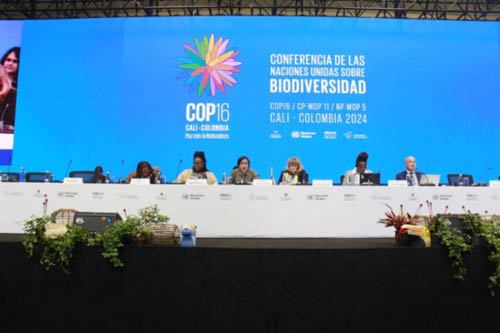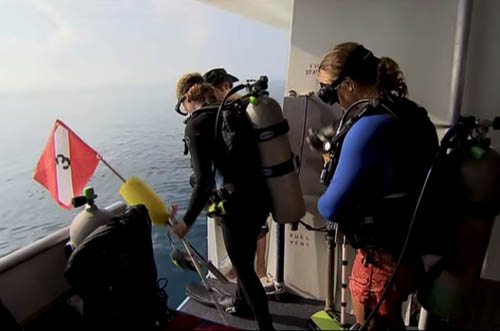 | | | As the days grow shorter and the crisp chill of November sets in, the coasts and oceans undergo transformations both visible and hidden. As we celebrate Thanksgiving and reflect on a season of gratitude, this month’s Observer invites readers to explore the intricate connections between human lives and marine ecosystems, especially as the COP16 Biodiversity Conference in Colombia comes to a close.  The articles in this issue dive into the pressing challenges facing marine life, from habitat restoration to innovative strategies for conservation. Seagrass meadows and coral reefs – vital ecosystems that capture carbon and support biodiversity – are under threat from warming waters and human activity. Efforts to restore these habitats highlight the ways nature can recover when given the chance, offering hope in a time of environmental urgency. To learn more, make sure to check out the free documentary series, Changing Seas – Our Oceans in Peril! in our “Video and Film” section. The articles in this issue dive into the pressing challenges facing marine life, from habitat restoration to innovative strategies for conservation. Seagrass meadows and coral reefs – vital ecosystems that capture carbon and support biodiversity – are under threat from warming waters and human activity. Efforts to restore these habitats highlight the ways nature can recover when given the chance, offering hope in a time of environmental urgency. To learn more, make sure to check out the free documentary series, Changing Seas – Our Oceans in Peril! in our “Video and Film” section. Clean energy takes the spotlight in our “Climate and Energy” section as offshore wind projects continue to expand, offering a promising alternative to fossil fuels. Balancing this progress with the protection of marine habitats is a key focus for policymakers and researchers alike, especially as the Biden administration continues to support marine energy research and development. However, political and economic uncertainties loom over offshore wind energy as legal experts unpack the implications of Trump’s proposed ban. November provides a timely moment to reflect on the progress being made, and the challenges that lie ahead in building a sustainable future.  On the international stage, COP16 in Colombia marked a significant victory for marine biodiversity, as nations agreed to protocols for protecting unique areas of the high seas. This milestone, coupled with the inspiring vision of projects like the "8th Continent," a self-sustaining structure designed to recycle ocean plastic, highlights a global commitment to ocean conservation. On the international stage, COP16 in Colombia marked a significant victory for marine biodiversity, as nations agreed to protocols for protecting unique areas of the high seas. This milestone, coupled with the inspiring vision of projects like the "8th Continent," a self-sustaining structure designed to recycle ocean plastic, highlights a global commitment to ocean conservation.
Closer to home, the stories in our section “Sustainability and Fish” about Gulf Coast shrimpers struggling to sustain their livelihoods and the urgency of addressing plastic pollution’s systemic impacts remind us of the human and ecological stakes. Yet, these challenges are met with innovation and resilience – whether through sustainable seafood practices or cutting-edge designs like the battery-powered seaglider, which promises a climate-friendly future for coastal travel.  This month’s Observer also delves into the often-overlooked voices of marine life. From whales mistaking plastic for prey to collaborative efforts to treat marine mammals poisoned by toxic algae, these stories offer sobering insights into the ripple effects of human activity on ocean creatures. This month’s Observer also delves into the often-overlooked voices of marine life. From whales mistaking plastic for prey to collaborative efforts to treat marine mammals poisoned by toxic algae, these stories offer sobering insights into the ripple effects of human activity on ocean creatures.
Finally, as migratory species travel vast distances and marine ecosystems prepare for seasonal changes, this month is a fitting time to consider our role in protecting these delicate connections. Each piece in this issue highlights the importance of acting with urgency and care to ensure a thriving future for our oceans. With the changing seasons comes a renewed sense of responsibility to preserve the coasts and oceans that sustain life on Earth. RCC’s Coasts and Ocean Observer continues to shine a light on these vital issues, offering both insight and inspiration for the work ahead. | | | | | | | |  RCC Presidential Fellow – Jack Sanitate RCC Presidential Fellow – Jack Sanitate
RCC Presidential Fellow, Jack Sanitate, is a senior at Duke University double majoring in Public Policy and Theater Studies, with a minor in Environmental Sciences & Policy. Jack serves as the co-lead of the RCC Coasts and Ocean program with Bob Musil and editor of the RCC Coasts and Ocean Observer. | | | | | | Rowan-involved Deep Sea Research Probes Climate Change in North Atlantic Three Rowan University scholars – a faculty member, a recent graduate and a Ph.D. student – took part in a North Atlantic research expedition from August to September to study global climate change and the depths to which it is becoming ever more critical. Beth Christensen, Ph.D., professor and founding chair of the Department of Environmental Science in Rowan’s School of Earth & Environment (SEE), said the deep sea excursion aboard the Sarmiento de Gamboa, a Spanish research vessel, included 15 international scientists. | | | | | | | | Trump’s Offshore Wind Ban Pledge Faces Legal Obstacles Trump said he’ll end offshore wind “on day one.” Experts say he can’t do that, but his administration could cause plenty of trouble for the nascent industry. Few clean energy sectors have been threatened as directly by Donald Trump as offshore wind. The president-elect vowed on the campaign trail to end offshore wind development via executive order “on day one” of his second term. | | | | | | | | Human-caused Ocean Warming Intensified Recent Hurricanes, Including All 11 Atlantic Hurricanes in 2024 Researchers determined that 44% of the economic damages caused by Hurricane Helene and 45% of those caused by Hurricane Milton could be attributed to climate change. Research published in the journal Environmental Research: Climate, “Human-caused ocean warming has intensified recent hurricanes,” found that between 2019 and 2023, the maximum sustained winds of Atlantic hurricanes were 19 mph (31 km/h) higher because of human-caused ocean warming. | | | | | | | | Louisiana voters agree to put offshore wind Energy Revenue Into Coastal Projects Louisiana is just putting its toe in the water of offshore-based wind energy development, but any revenue such projects generate for the state will go toward coastal projects after voters approved a constitutional amendment Tuesday locking in the dedication. Final but unofficial results from the Louisiana Secretary of State showed 73% of voters supported the ballot measure that would devote dollars to undertakings such as barrier island restoration and wetlands rebuilding. | | | | | | | | DOE Office Announces $1.7 Million For Hydropower and Marine Energy Projects at National Labs The U.S. Department of Energy’s (DOE) Water Power Technologies Office (WPTO) announced more than $1.7 million for 16 hydropower projects and 12 marine energy projects to further water power research and development at DOE’s national laboratories. These projects will advance hydropower and marine energy technologies and their roles in achieving both national and local clean energy goals. | | | | | | | | Battery-powered Sea Glider Could Make Coastal Travel More Climate-friendly It’s a bird, it’s a plane, it’s a boat … it’s … what is that? Thalheimer: “A sea glider is an all-electric, battery-powered flying boat.” Billy Thalheimer is cofounder and CEO of Regent, a company that’s developing a 12-seat seaglider called the Viceroy. It looks similar to a plane. But when operated, it starts out floating on its hull, like a boat. It rises up onto a hydrofoil – a winglike structure that lifts it slightly above the water. Then in open water, it takes off and cruises on a cushion of air near the water’s surface. | | | | | | | | How the Oceans Fared at the COP16 Biodiversity Conference in Colombia The announcement came early on the morning of Oct. 31. Delegates to the United Nations Convention on Biological Diversity summit (COP16) in Cali, Colombia, had finally agreed on a protocol for identifying for protection unique parts of the high seas, the two-thirds of the world’s oceans that are international waters. The late-conference acceptance of this science-based process for pinpointing ecologically or biologically significant marine areas, or EBSAs, in the high seas provides a pathway to create marine protected areas (MPAs) in international waters. | | | | | | | | Nature Is a Right, Not a Privilege: Environmental Education as a Catalyst for Youth-Led Climate Justice For someone interested in the environment, I have killed more plants than I care to tell. Since high school, I have rooted myself (pun intended) in a curiosity of nature. Research presented an outlet through which I felt comfortable exploring my environmentalism. Admittedly, I was the basement-dwelling, science-experiment kid, tending to my plants and their fungal mutualisms every day after school. | | | | | | | | | | Whales That Use Echolocation Mistake Plastic For Prey Deep-diving whales that rely on sound rather than vision to hunt in the ocean’s darkest depths are confusing plastic marine debris for prey, new findings suggest. For the study, “Acoustic signature of plastic marine debris mimics the prey items of deep-diving cetaceans,” researchers from Duke University as well as the National Oceanic and Atmospheric Administration, North Carolina State University and the University of North Carolina Chapel Hill, compared the way sound bounces off plastic that is floating underwater to that of typical whale prey. | | | | | | | | Plastic Pollution is Changing Entire Earth System, Scientists Find Pollution is affecting the climate, biodiversity, ecosystems, ocean acidification and human health, according to analysis Plastic pollution is changing the processes of the entire Earth system, exacerbating climate change, biodiversity loss, ocean acidification, and the use of freshwater and land, according to scientific analysis. Plastic must not be treated as a waste problem alone, the authors said, but as a product that poses harm to ecosystems and human health. | | | | | | | | Decades After Global Regulations, the Arctic Ocean's Legacy Persistent Organic Pollutants Haven't Dropped The presence of persistent organic pollutants (POPs) in all the world's oceans but one has been in steady decline since 2001, when 152 countries agreed on a comprehensive global ban. The exception has been the Arctic Ocean, which has seen a sharp rise in POPs in its frigid waters over the past several decades. | | | | | | | | Majestic ‘8th continent’ Collects and Recycles Plastic From the Ocean Architect Lenka Petráková’s “The 8th Continent” proposes a self-sustaining structure to recycle ocean plastic and restore marine health. Award-winning architect Lenka Petráková is pioneering a new way to tackle ocean pollution with an ambitious project named "The 8th Continent." Her innovative design aims to recycle ocean plastic while functioning as a completely self-sustaining floating structure. If realized, it could mark a significant advancement in global conservation efforts. | | | | | | | | Gulf Coast Shrimpers Are Going Out of Business With Alarming Speed Murry Kimball never wanted to be a shrimper. The 64-year-old spent much of his childhood learning the ways of the ten-legged crustacean; anytime school wasn’t in session, he and his younger brother would be dragged out to work on their father’s boat in the Gulf waters of southeast Texas. “I stayed seasick,” Kimball remembers. “I hated shrimping so much, I wanted to become a game warden and shut my daddy down.” | | | | | | | | Biden Administration Announces USD 95 Million For Fish Passage Projects The U.S. government has announced another USD 95 million (EUR 87 million) in funding for new fish passage projects, some of which is specifically dedicated to Tribal priorities. “These investments reflect a continuation of decades of work by NOAA Fisheries to recover threatened and endangered migratory fish and support the sustainability of commercial, Tribal, and recreational fisheries,” NOAA Fisheries Assistant Administrator Janet Coit said in a statement. | | | | | | | | Whitefish Remains Vanguard of Sustainable Seafood Market Whitefish fisheries including pollock, cod, haddock and hake, remain at the forefront of the sustainable seafood market, with almost three quarters of the global whitefish catch engaged with the MSC’s sustainable seafood program at the end of 2023. Pollock and cod are among the top ten wild caught marine species with the largest landings in 2021 – the latest year for which the UN’s Food and Agriculture Organisation (FAO) provides data. | | | | | | | | OpEd: Salmon-farming Industry Has to Take Protecting Biodiversity Seriously to Guarantee Stable Future He was trained as an economist and specialized as a researcher on governance and management policies of sustainable fisheries and oceans. Currently, he works as a senior policy advisor for the NGO Accountability. His latest book, “Tuna Wars. Powers around the fish we love to conserve’,’ describes the world history of industrial tuna fisheries from antiquity to the modern economic battles around sustainability in the value chain. | | | | | | | | A Night of Beauty and Sadness in Florida In high school, a five-day trip to the Florida Keys was the highlight of my year, a getaway planned by our AP Environmental Science class to explore marine ecosystems up close. I had spent the week prior buzzing with anticipation, carefully packing my duffel bag full of swimsuits, breathable tees, and my favorite hiking sandals. Trading the brisk Virginia air for tropical breezes sounded like a dream, and I couldn’t wait to see what adventures awaited. By the time our plane touched down in Miami, I was ready to dive into the experience. | | | | | | | | From Crisis to Comeback: Long Island’s $6 Billion Clean Water Victory The universal need for clean water transcends all politics. In a landmark victory for clean water, Suffolk County residents approved Proposition 2. Over the next 30 years, this measure will secure $4 billion to modernize wastewater infrastructure and protect Long Island’s waters from nitrogen pollution and $2 billion to protect clean drinking water by conserving nature. This monumental non-partisan decision marks a turning point in the decades-long effort to restore the region’s beaches, bays and harbors. | | | | | | | | Do Hurricanes Pose a Danger to Fish and Other Sea Life? According to an article on the National Oceanic Atmospheric Association website, hurricanes generate high waves, rough undercurrents and shifting sands, and all three may harm sea life. “Slow-moving fish and turtles and shellfish beds are often decimated by the rough undercurrents and rapid changes in water temperature and salinity wrought by a hurricane,” the article states. | | | | | | | | Collaborative Research Aims To Discover Effective Treatments for Marine Mammals Poisoned by Toxic Algae Zymo Research Corporation, Unravel Biosciences, Inc., and Channel Islands Marine & Wildlife Institute (CIMWI) have joined forces in an urgent research initiative to identify drug therapies for marine mammals affected by domoic acid (DA) poisoning. As climate change drives environmental shifts that increase the frequency of harmful phytoplankton blooms, marine life, especially sea lions, face an escalating threat from DA toxicity. | | | | | | | | | | | | Jan. 31, 2024  Scientists and explorers uncover the wonders of Earth's underwater wilderness. Along the way, they make scientific breakthroughs and highlight how human activity can impact the oceans. Scientists and explorers uncover the wonders of Earth's underwater wilderness. Along the way, they make scientific breakthroughs and highlight how human activity can impact the oceans.
Episode 1: No Fish Left Uncounted - 00:00:00
How do you count two fish, three fish or even a school of fish? A team of scientists joined forces to conduct a massive fish census in Dry Tortugas National Park.
Episode 2: Sentinels of the Seas - 00:25:43
Bottlenose dolphins are a Florida icon. But recent studies show disturbing signs of immune system dysfunction and disease plaguing this charismatic mammal. Episode 3: Seagrasses and Mangroves - 00:51:24
They are an ancient species of flowering plants that grow submerged in all of the world’s oceans. Seagrasses link offshore coral reefs with coastal mangrove forests. Episode 4: Sinking the Vandenberg - 01:17:05
Off Key West lies the world's second largest intentionally sunk shipwreck, the USNS General Hoyt S. Vandenberg. This artificial reef is attracting fish, anglers and divers. | | | | | | The November 2024 issue of RCC's Coasts and Ocean Observer was produced by Ross Feldner | | | | | |  The Rachel Carson Council Depends on Tax-deductible Gifts From Concerned Individuals Like You. Please Help If You Can. The Rachel Carson Council Depends on Tax-deductible Gifts From Concerned Individuals Like You. Please Help If You Can. | | | | | | | |  Sign Up Here to Receive the RCC E-News and Other RCC Newsletters, Information and Alerts. Sign Up Here to Receive the RCC E-News and Other RCC Newsletters, Information and Alerts. | | | | | | | | | | | |